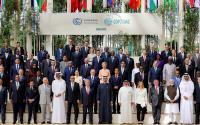21 September 2006Juliet Eilperin
The Bush administration yesterday laid out a long-term "strategic plan" for using technology to curb the impact of global warming, reiterating its position that basic scientific research and voluntary actions can curb greenhouse gases linked to climate change.
Addressing complaints by environmentalists and some scientists that Bush has not done enough to cut the nation's emissions of such gases, Energy Secretary Samuel W. Bodman said the 244-page "Climate Change Technology Program Strategic Plan" promotes initiatives such as sequestering carbon dioxide before it enters the atmosphere and promoting hydrogen-powered cars.
"This plan was inspired by the President's vision to harness America's strengths in innovation and technology to transform energy production and use in ways that significantly reduce greenhouse gas emissions over the long term," Bodman said in a statement. "This strategic plan is unprecedented in its scope and scale and breaks new ground with its visionary 100-year planning horizon, global perspective, multilateral research collaborations, and public-private partnerships."
Energy Department officials described the plan -- which has taken four years to produce -- before the House Science subcommittee on energy yesterday. It immediately came under fire from senior Hill Republicans as well as several outside scientists and policy experts.
"It's good as far as it goes, but it needs to go a lot further," House Science Committee Chairman Sherwood L. Boehlert (R-N.Y.) said in an interview after the hearing. "It's good to look ahead, but people expect something immediate, as well as futuristic."
House Government Reform Committee Chairman Thomas M. Davis III (R-Va.), who has scheduled a hearing today on climate change research, said the administration failed to spell out how future research will be funded.
"They address the need for research but give a very convoluted answer as to how that's going to occur," Davis said in an interview. "What we're asking is, is this sufficient? You've got to have some teeth and focus."
In the document, the administration said it spends $3 billion a year on the research.
But Ken Caldeira, a senior scientist at the Carnegie Institution at Stanford University, said the country would have to spend "hundreds of billions of dollars a year" to move away from a carbon-dependent economy. He added that the government would have to regulate carbon dioxide emissions, either through a tax or cap-and-trade system, to create incentives to develop and implement cleaner technologies.
"Most energy technologies that do not emit carbon dioxide to the atmosphere will cost more than those that do emit carbon dioxide to the atmosphere," Caldeira said. "A major energy R&D program only makes sense in the context of a price on carbon emissions."
Rafe Pomerance, who chairs the bipartisan Climate Policy Center, praised the administration for emphasizing the need for exploratory research to produce innovative responses to global warming.
Some outside scientists, such as William Fulkerson, a senior fellow at the University of Tennessee's Institute for a Secure and Sustainable Environment, said the plan could provide a blueprint for encouraging the development of technologies that would cut emissions. "It makes it clear this is a long-term issue and it is not solved by any one technology or strategy," Fulkerson said.
Margo Thorning, chief economist at the American Council for Capital Formation, said the plan is "a substantial, credible effort" to address global warming.
"The technology-based approach is the only way to go, and the administration's emphasis on that is the right one," said Thorning, whose think tank accepts money from Exxon Mobil Corp.
John Coequyt, an energy policy specialist for the advocacy group Greenpeace, said that the plan's biggest flaw is shown by the 2010 start of its initial goals.
"The big picture from the Bush administration is always the same: This is a long-term problem that will be solved by another administration," Coequyt said. "It's time to start talking about what are the things we can do tomorrow."
http://www.washingtonpost.com/wp-dyn/content/article/2006/09/20/AR2006092001697.html






